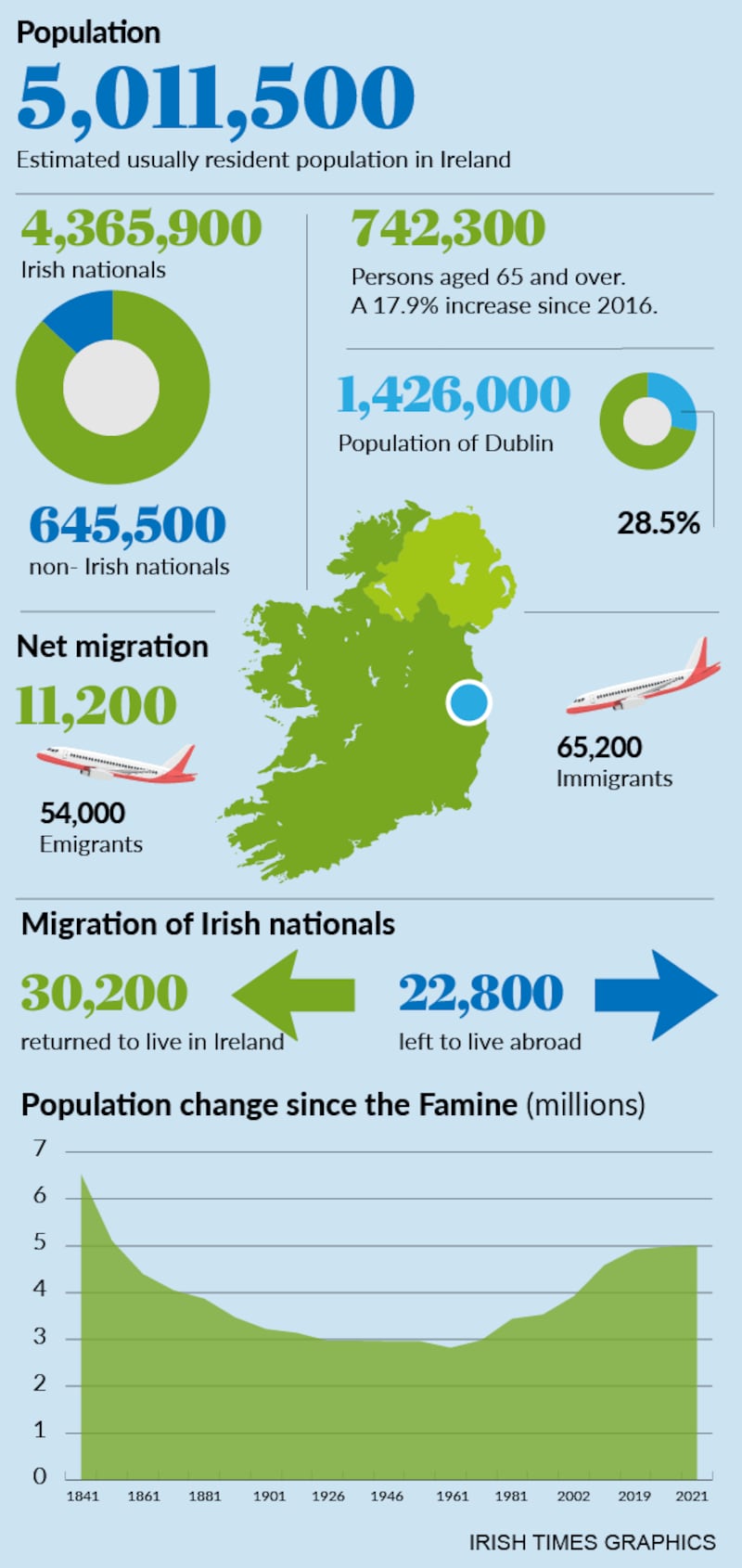No European country, perhaps no modern country, has experienced a more unique, a more traumatic population trajectory than Ireland. It is the only European country where the population is still lower than it was 170 years ago. Central Statistics Office (CSO) figures, published on Tuesday, put the State's population in April 2021 at 5.01 million. The last time it was over five million was in 1851 when it was 5.11 million. It is also the only country in Europe where the population is 78 per cent bigger than it was just 60 years ago. In 1961, the population was 2.8 million, an all-time low. If you knew nothing of Ireland's history, knew nothing of the Famine or the country's long pattern of emigration or the State's early and persistent economic failures, you could tell something difficult, something tumultuous had happened just from our demographic footprint.
We missed out on the post-war baby boom, which spurred massive population surges in the US and Europe. In the 1990s, we were still experiencing net outward migration – unique in western European terms back then and a reflection of the economic mismanagement that reigned in the 1970s and 1980s. As historians like to say, the Celtic Tiger was preceded by a Celtic Tortoise.
If we bucked the trend back then, we’re still bucking it now. Our population is still growing relatively strongly when other countries are experiencing declines. We have the highest birth rate and the lowest death rate in the EU27.
What you tend to see across the world is that when countries become more prosperous, the birth rate goes down. While the Republic’s has been declining since 2008, it is still comparatively strong.
The CSO’s 2021 data does point to a marked slowdown in the pace of population growth. The annual change in the year to April 2021 was 34,000, the smallest gain since 2014 and notably lower than 56,000 increase recorded in the previous year.
While some of this slowdown might be what demographers call “trend easing”, much of it has to relate to the pandemic, specifically the curbs on international travel.

Inward migration
As KBC Bank Ireland economist Austin Hughes noted, the slowdown in Irish population growth in 2021 was primarily driven by a sharp fall-off in net migration reflecting health-related restrictions on travel.
Net inward migration was markedly lower at just 11,000 compared to 29,000 in 2020. “While the ‘natural’ increase (births less deaths) also slowed marginally to 23,000 from 27,000, this was largely due to the persistence of a downward trend in births rather than a marked change in the death rate that rose only modestly from just over 31,000 to just under 32,000,” he says.
“The comparatively rapid increase in Ireland’s population offers substantial economic opportunities in the shape of an increasing labour force and less immediate ageing pressures that provide an altogether more supportive backdrop than that now facing many EU countries,” Hughes says.
“While there is no automatic relationship between population and GDP growth, Ireland’s continuing demographic dividend should provide a positive impetus to economic activity in coming years,” he says.
What he’s saying here is that our population is being boosted by two forces. First the strong natural increase, which has resulted in a relatively younger, more educated workforce.
Second, our inward migrants tend to be economic migrants rather than refugees. Both these forces have boosted the country’s stock of human capital, a point that’s often cited by multinationals as a reason for locating here.
Major bottlenecks
Having a bigger, younger, potentially more educated workforce means additional economic output and additional tax revenue, and ultimately a more prosperous society. But if these population trends aren’t facilitated with a significant increase in public investment, they can backfire. We’ve already begun to experience major bottlenecks in housing, health, water and education. Prior to the pandemic, analysts had linked a slowdown in net inward migration to capacity issues. The population of Dublin is now estimated to be 1.43 million, 28.5 per cent of the total population.
Managing these capacity issues is perhaps the biggest challenge facing the Government besides climate change.
Bottlenecks in areas such as health are also likely to become more acute as the population ages. The Economic and Social Research Institute (ESRI) warned the Government recently that future spending pressures linked to demographics – combined with potential declines in corporation tax – are likely to result in higher taxes, not in the longer term, but in the near to medium term.
The CSO figures show those aged 65 and over were the only group to gain population share between 2016 and 2021, increasing from 13.3 per cent to 14.8 per cent of the total, equating to a volume increase of 112,500.
A key problem brewing at the heart of Irish society centres on the interaction between population, housing and pensions. A bigger, younger population needs more houses, which we’re struggling to build. This is compounded by the fact that housing has become too expensive in the cities, meaning most young workers must rent. But what happens when these workers retire? Will they be able to afford the requisite rent in retirement and with the meagre level of pension coverage that currently exists?
This article was updated on September 1st as a previous version stated the 1961 population was 2.1 million. This has been corrected.
















